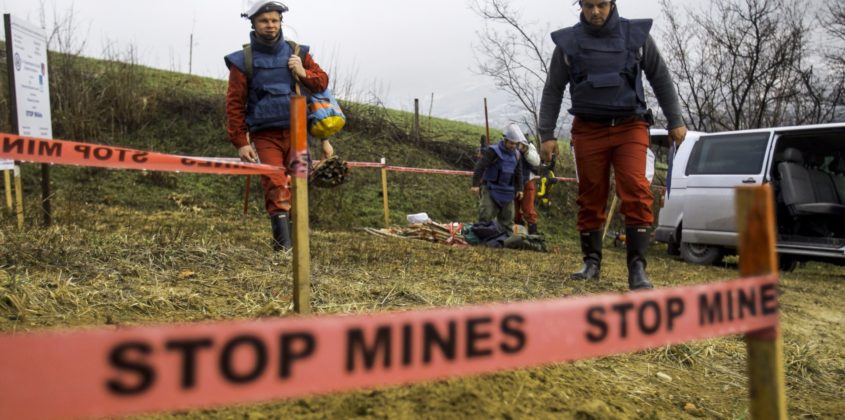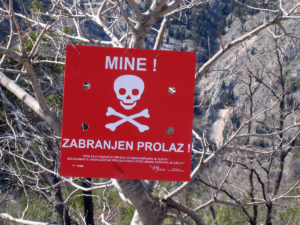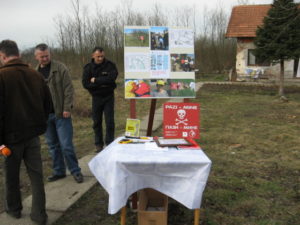Bosnia And Herzegovina Is Still Tackling The Issue Of Landmines

The Bosnian war of 1992 – 95 may have been over more than two decades ago but the region may never get rid of all the mines planted during the war. Since 1996, more than three thousand square kilometers have been cleared of mines by Serb-majority Republika Srpska and the Federation of Bosnia and Herzegovina.

Statistic shows that 2.2 percent of the country’s landmass or 1,000 square kilomters still remain hazardous. Over 1,750 people have been hit so far from land mines. Out of that figure, 612 were fatal. It is estimated that the number of land mines still buried in the area could reach 80,000.
In 2012, Ibrahim Bijelic was out in the woods with his son collecting woods when his son unintentionally triggered one of the land mines. Shrapnel pierced the boy’s heart and he died while Bijelic’s body is laden with shrapnel – and surgery remains too dangerous.
“It happened in the nearby woods, not far from our house. I have been to that place collecting firewood again and again. The area was considered safe and there haven’t been any accidents in the past, but this time… I carried the boy’s body and walked through the forest as fast as I could… but it was too late.”
Source: Aljazeera

The initial target was to have the country free of land mines by 2009 but the targets have continually been pushed back. One of the major constraints to achieving the target is financial constraints. In April, 2017, Balkan Insight reported that only half of the earmarked $512 million for the de-mining process has been channeled to it.
According to Sasa Obradovic of the Bosnia and Herzegovina Mine Action Center, it would take $54 million per year to clear the country of land mines. The 2009 mine-free goal by the country had to be postponed for a decade (to 2019) but the new date seems Utopian. Experts say it will take at least 5 years to clear the region of post-war land mines.
Bosnia and Herzegovina celebrated this year’s International Mine Awareness Day with a presentation on demining in Sarajevo outside parliament. Operational manager at UDAS, Gordana Sekaric, an amputee representing organization warns that the country will fail to meet the target largely due to lack of funds.
“[The government] should do more to implement the obligations arising from Bosnia’s Mine Action Strategy 2009 – 2019, which is sadly still not being implemented properly – allegedly due to a lack of funds.”
Source: Balkan Insisght
The majority of the past demining actions have been focused on urban areas but the rural areas remain highly vulnerable. 129 of the total 143 municipalities in the country face this problem. The most dangerous areas include Ilijas, Gornji Vakuf, Kladusa, Doboj, Maglaj, Sanski Most, and Travmik.

NATO’s annual exercise in the Balkans is usually geared towards training the participants on new emergency response techniques. Bosnia and Herzegovina hosted the 2017 exercise with Serbia slated to host the next.
The problem took a twist in 2016 with the launch of the virtual reality game Pokémon GO. The game challenged players to hunt and train Pokémon. A local NGO had to dish out warning to players of Pokemon GO not to wander into potentially dangerous areas.
Notwithstanding that the war in Croatia ended late in 1995, more than two hundred people have been reported killed by landmines including de-miners and civilians. To sustain the peace in the region, EU continues to extend its mission in Bosnia and Herzegovina nothing that there are still unresolved issues that makes the peace in the area volatile.

In 2014, the heavy flood that swept through Bosnia and Herzegovina washed away infrastructure, homes, and moved thousands of landmines across enormous areas. This threatened recovery efforts as well as put the lives of the residents at risk.
The United Nations Central Emergency Response Find (CERF) donated $2 million which aided the United Nations Development Programme (UNDP) and numerous other humanitarian partners to start an emergency recovery operation in the area. The locations of the large mines are obvious but it is the isolated individual mines that pose the greatest danger.
